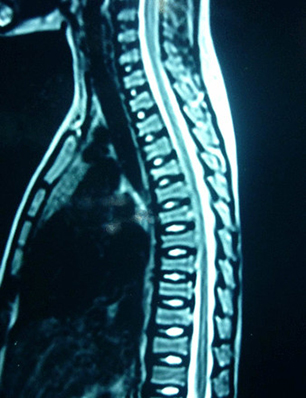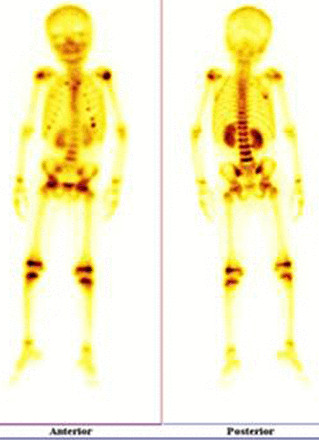Approach
Diagnosis of malignancy-associated hypercalcemia is based on a history of malignancy, signs/symptoms of hypercalcemia, presence of hypercalcemia, and biochemical workup to determine the underlying etiology of hypercalcemia.
History and physical exam
Symptoms of hypercalcemia include neuropsychiatric changes (e.g., mood disturbance, fatigue, confusion, stupor, and coma), gastrointestinal disturbance (loss of appetite, nausea, constipation), muscle weakness, polyuria, polydipsia, and bone pain.[1][2][5][10][13] Signs of dehydration associated with hypercalcemia include poor skin turgor and dry mucous membranes. However, hypercalcemia may not be associated with any specific physical examination findings.
History to evaluate potential causes of hypercalcemia unrelated to malignancy should be elicited.[1][5] These include hyperthyroidism, pheochromocytoma, adrenal insufficiency, and granulomatous disease. A thorough medication history to evaluate for use of medications that may cause or worsen hypercalcemia (thiazide diuretics, lithium, calcium, over-the-counter antacids, and large doses of vitamin D) should be undertaken.[1][5][10]
Severity of symptoms may correlate with duration and rapidity of onset of hypercalcemia.[10] It is important to note that malignancy-associated hypercalcemia is less commonly associated with life-threatening decompensation, but a hypercalcemic crisis (characterized by oliguria, anuria, somnolence, coma) can occur.
An ECG should be performed to assess for a shortened QT interval and dysrhythmias.
Laboratory evaluation
Biochemical evidence of hypercalcemia should be demonstrated by measuring total serum calcium and albumin in order to calculate the adjusted serum calcium level. Some sources prefer measurement of serum ionized calcium, if available. Serum ionized calcium should be measured if the albumin level is altered, and if calcium-binding immunoglobulins may be present (e.g., in multiple myeloma).[1]
Parathyroid hormone (PTH)-dependent hypercalcemia should be ruled out by measuring a serum intact PTH level.[5] Conditions associated with elevated PTH include primary and tertiary hyperparathyroidism, familial hypocalciuric hypercalcemia, and ectopic hyperparathyroidism.
A complete metabolic panel should be ordered to check for hypercalcemia-induced acute kidney injury. A high bicarbonate level may indicate that malignancy or exogenous calcium excess may be a more likely cause of hypercalcemia than primary hyperparathyroidism.
The etiology of non-PTH-dependent hypercalcemia should be determined. Conditions associated with hypercalcemia and an appropriately suppressed PTH include malignancy-associated hypercalcemia, hyperthyroidism, pheochromocytoma, and adrenal insufficiency.
All laboratory tests should be obtained before treatment is started, as improvement of hypercalcemia after treatment is initiated may cause difficulty in interpreting test results. The following tests are also recommended:
Screening for hyperthyroidism, pheochromocytoma, and adrenal insufficiency, as clinically indicated.
Serum parathyroid hormone-related peptide (PTHrP). An elevated PTHrP associated with a suppressed PTH and low to low-normal calcitriol (1,25-dihydroxyvitamin D) level represents likely humoral hypercalcemia of malignancy. PTHrP-mediated hypercalcemia typically occurs with nonmetastatic tumors that may be apparent on exam and initial imaging. Exceptions include small neuroendocrine tumors.[1]
Serum phosphorus. In humoral hypercalcemia of malignancy, PTHrP also acts at the level of the kidney to reduce calcium clearance, as well as to reduce the renal phosphorus threshold, leading to hyperphosphaturia and hypophosphatemia.[1][5]
Calcitriol (serum 1,25-dihydroxyvitamin D) level, if lymphoma and/or granulomatous disease are suspected. Calcitriol (1,25-dihydroxyvitamin D)-mediated hypercalcemia occurs with lymphomas of all kinds and granulomatous disorders.
Serum 25-hydroxyvitamin D, if intravenous bisphosphonate or subcutaneous denosumab is being considered. Vitamin D deficiency should be corrected prior to administration of bisphosphonates or denosumab to avoid the risk of hypocalcemia and, possibly, osteonecrosis of the jaw.[17][18][19][20]
If there is a history of malignancy complicated by skeletal involvement, PTHrP and calcitriol (1,25-dihydroxyvitamin D) are found to be normal, and other etiologies of hypercalcemia have been eliminated, local osteolytic hypercalcemia is the most likely diagnosis.[Figure caption and citation for the preceding image starts]: CT chest showing compression fracture of multiple vertebral bodies in a child presenting with acute lymphoblastic leukemia. Biochemistry showed hypercalcemia with a suppressed parathyroid hormone levelSukumar SP, Balachandran K, Sahoo JP, et al. Acute lymphocytic leukaemia presenting as a metabolic bone disease. BMJ Case Reports 2013; doi:10.1136/bcr-2013-008758 [Citation ends]. [Figure caption and citation for the preceding image starts]: Whole body planar images suggestive of skeletal infiltration in a child with acute lymphoblastic leukemia showing areas of abnormal increased uptake. Biochemistry showed hypercalcemia with a suppressed parathyroid hormone levelSukumar SP, Balachandran K, Sahoo JP, et al. Acute lymphocytic leukaemia presenting as a metabolic bone disease. BMJ Case Reports 2013; doi:10.1136/bcr-2013-008758 [Citation ends].
[Figure caption and citation for the preceding image starts]: Whole body planar images suggestive of skeletal infiltration in a child with acute lymphoblastic leukemia showing areas of abnormal increased uptake. Biochemistry showed hypercalcemia with a suppressed parathyroid hormone levelSukumar SP, Balachandran K, Sahoo JP, et al. Acute lymphocytic leukaemia presenting as a metabolic bone disease. BMJ Case Reports 2013; doi:10.1136/bcr-2013-008758 [Citation ends].
Radiology evaluation
In order to assess for underlying causes of hypercalcemia, the following tests should be considered:
Skeletal survey in patients in whom multiple myeloma, bone metastases, or leukemia are suspected.
Chest x-ray to assess for lung cancer, sarcoidosis, or tuberculosis.
Further imaging should be ordered, according to the suspected cancer or condition and the anatomic region involved.
Other tests
An ECG should be performed to look for shortened QT interval or other conduction abnormalities.[2]
Use of this content is subject to our disclaimer